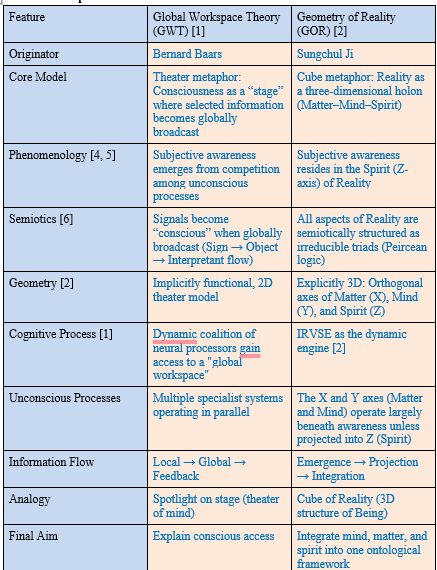By Sungchul Ji, Ph.D.
Professor Emeritus of Theoretical Cell Biology, Rutgers University
(with the assistance of ChatGPT)
“The human mind is not a spotlight, but a stage.” — Bernard Baars
“Reality is a holon with three irreducible components: matter, mind, and spirit.”
— Sungchul Ji
1. Introduction
In recent decades, Bernard Baars’s Global Workspace Theory (GWT) [1] has become one of the most influential cognitive models of consciousness. In parallel, the Geometry of Reality (GOR) (see Figures 1 and 2 below) offers a cosmological framework that seeks to integrate matter, mind, and spirit as three orthogonal but interdependent dimensions of Reality [2].
This article explores how GWT and GOR (Figures 1 and 2) can be understood as converging on a common insight: consciousness arises through structured coordination among multiple subsystems, and this structure may be best understood in terms of triadic organization [3].
Table 1. Comparative Overview: GWT vs. GOR
2. Deep Dive: GWT as a Projection onto the GOR Cube
If we imagine the Geometry of Reality as a cube defined by three axes:
- X-axis: Matter (Physicality, Variation)
- Y-axis: Mind (Information, Selection)
- Z-axis: Spirit (Consciousness, Environment)
then Baars’s GWT can be visualized as an emergent XY projection of conscious processes that acquire a Z-component when globally broadcast. In other words:
Global broadcasting = projection from the XY plane (Matter–Mind) into the XYZ-cube (Experience including Spirit/Conscious Awareness).
This interpretation aligns GWT with the Peircean triad (Sign–Object–Interpretant) and with the IRVSE mechanism, where selection by the environment (Z) determines which internal processes (XY) rise to conscious access.
3. Why This Convergence Matters
- GWT explains the *how* of consciousness — what cognitive structures make it possible.
- GOR explains the *why* of consciousness — what ontological role it plays in the broader architecture of reality.
Together, they reveal that:
- Consciousness is not just functional but foundational.
- The conscious mind is not isolated but emergent from structured, triadic dynamics.
4. Toward a Meta-Theory of Mind and Reality
By bringing together Baars’s neurocognitive functionalism and Ji’s biosemiotic cosmology, we glimpse a deeper principle:
Consciousness emerges when information becomes structured within an irreducible triadic geometry.
This insight may help unify neuroscience, cosmology, and philosophy into a new synthesis—one that places consciousness not at the margins of science, but at its very center.
5. Closing Thought
In the Global Workspace, information becomes conscious.
In the Geometry of Reality, consciousness becomes cosmic.
— Sungchul Ji, 2025
References:
[1] Global Workspace Theory. https://en.wikipedia.org/wiki/Global_workspace_theory
[2] Ji, S. (2025). Geometry of Reality. https://622622.substack.com/p/geometry-of-reality
[3] Ji, S. (2018). The Universality of the Irreducible Triadic Relation. In: The Cell Language Theory: Connecting Mind and Matter. World Scientific Publishing. Pp. 377-393.
[4] Phenomenology. https://en.wikipedia.org/wiki/Phenomenology (philosophy)
[5] Maurice Merleau-Ponty. https://en.wikipedia.org/wiki/Maurice_Merleau-Ponty
[6] Semiotics. https://en.wikipedia.org/wiki/Semiotics





